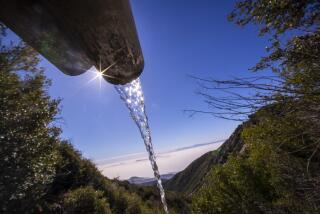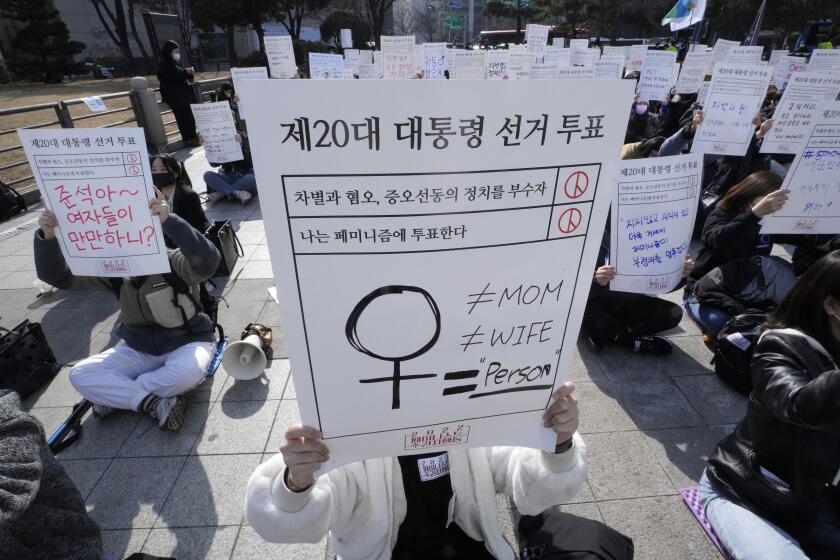Singapore Reclaims Water, and Its Self-Sufficiency
- Share via
SINGAPORE — In this prosperous island city-state, the latest way to promote the nation’s independence might seem a bit revolting: drinking water recycled from residents’ sewage.
But brushing aside coarse jokes from citizens and snide remarks from neighboring Malaysia, Singapore’s earnest officials have launched a campaign to make the country more self-sufficient by the use of treated waste water called “NEWater.”
“We now have our own water,” Prime Minister Goh Chok Tong declared recently as he drank a small promotional bottle of NEWater after a tennis match.
Ultimately, the government plans to introduce the reclaimed water into the city’s water system and deliver it as tap water.
Tropical Singapore, half the size of the city of Los Angeles, relies heavily on water from Malaysia that is piped across the mile-wide Johore Strait separating the two countries.
With a major contract for cheap Malaysian water set to expire in 2011, Singapore hopes to sell its 4.3 million people on NEWater as an alternative source.
Officials say that with the latest purification technology, the recycled waste water is perfectly safe to drink. The idea is much the same, they say, as the process that keeps astronauts supplied with water in space.
Many Singaporeans who have sampled the reclaimed water say it is nearly tasteless. Some prefer it to the city’s chlorinated tap water. Others say they can’t tell them apart.
“There’s no difference,” office worker Yee Lai Han said after trying NEWater for the first time. “The most important thing is to have water to drink.”
Water districts in some parts of the United States, including Orange County, have been mixing reclaimed waste water with ground water or other sources of drinking water since the late 1970s, Singaporean officials note.
“There is a water shortage worldwide because of population growth and urbanization,” Trade and Industry Minister George Yeo Yong Boon told reporters last week. “And this technology will not be used only in Singapore and a few other places, but in many places.”
In a country where political dissent is effectively muzzled, the NEWater campaign has given humorists a welcome opportunity to poke fun at the government.
“It’s totally natural, like Evian, except that it doesn’t come down from snowy alpine rivers but from your very own kidneys,” quipped the satirical Singaporean Web site talkingcock.com, which features a picture of a rooster, in one recent posting.
Referring to a recent economic downturn in Singapore, the Web site said that 2002 “will be looked on as a superb harvest year for NEWater. In that year, Singaporeans were asked to swallow a lot of things, from unemployment to fare hikes. These have enriched the taste of NEWater considerably.”
Just across the border in Malaysia’s southernmost state of Johor, Chief Minister Abdul Ghani Othman warned residents to watch out for Singapore’s water when they travel to the island.
“We from Malaysia should know that when we go to Singapore one day and drink coffee, the water comes from behind their kitchens or washrooms,” he said.
Relations between the former British colonies have often been strained since Singapore broke off from Malaysia to form its own country 37 years ago. Periodically, Malaysian officials threaten to turn off Singapore’s tap.
In a speech this year, Goh cited a November 2000 article by a Malaysian colonel that discussed the possibility of putting chemical or biological poisons into Singapore’s water supply.
“Without water, Singapore may not survive,” Lt. Col. Azmy Yahya wrote in the Malaysian Armed Forces Defense College journal, Strategi. “Malaysia should take full advantage of water as a strategic weapon to counter Singapore’s military advantage over Malaysia.”
Singapore is one of the few major cities in Southeast Asia with potable tap water.
The country has been operating its water purification system and producing NEWater for two years, mainly for industrial use.
It also operates a desalination plant, but reclaiming waste water is less costly than removing the salt from seawater.
Before officials add NEWater to the drinking water supply and mix it in the city’s reservoirs, the government is carrying out an education campaign to alleviate the public’s fears. On Aug. 9--Singapore’s independence day--the government introduced NEWater by giving away 60,000 promotional bottles.
“Over the National Day period, we’ve all got drunk on NEWater,” said Yeo, the trade and industry minister. “I think the response has been wonderful. There’s a sense that this technological breakthrough enables us to be self-sufficient if we have to be.”
Then, on Monday, Singapore began giving away bottles of the water at the offices of the Public Utilities Board. A steady stream of people came in to pick up the maximum six bottles for personal use. Officials estimated that they were handing out 1,000 bottles an hour. But they have no plans to sell NEWater by the bottle. The giveaway is scheduled to last a month.
“I think it’s fabulous,” said Ngiam Shing Kok, an office worker who stopped by to pick up half a dozen bottles. “It makes us self-sufficient. It’s always better if a person or country can rely on himself.”
More to Read
Sign up for Essential California
The most important California stories and recommendations in your inbox every morning.
You may occasionally receive promotional content from the Los Angeles Times.













